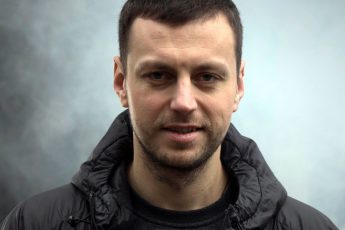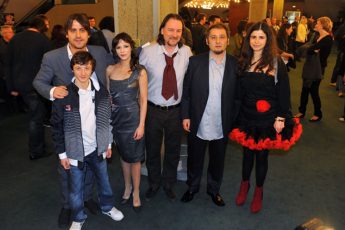
We met Anka and Wilhelm Sasnal in the Centre Pompidou in Paris where their film “It Looks Pretty from a Distance” was screened. We talk with them about their non-Polish influences, painting, poetry, and nature’s role in film.
It’s not looking very rosy for Polish films, they have a lot of money in comparison to other east European or central European countries but creativity wise I’m not very convinced, what do you think ?
A,W: Well this is certainly a problem. I think Polish filmmakers emphasize the story and not the language of cinema. This is what kills cinema, because cinema language is becoming obsolete. We actually feel quite awkward being put into this context (of Polish filmmakers). Honestly, we don’t like Polish contemporary cinema very much. We have respect for older films, and sometimes we get ideas from older great directors like Polanski and Wajda.
Are you inspired by filmmakers from other parts of the world?
A: Yes, we could say there are couple of films we really like. Bruno Dumont, and Ulrich Seidl, I like very much, and Haneke of course. The Romanian New Wave directors are also one of our references and there are so many films which obviously build our artistic influence.
W: We are not trained filmmakers ourselves. Anka studied literature and I studied painting, somehow our interests met and we decided to explore movies. I used to do short films at first, centered on music. I found music more important even than art. I started to make some media clips just for myself, I combined the footage I took by myself and used music I like, but it was always short forms, more like abstract art movies, there was no plot. But even today the plot is not that important in our films, even if it’s more present than in short films.
What made you go to the countryside? Did you do research about the location?
We grew up in a city. A small one, with a hundred or fifty-thousand people. The village we found is in-between our home-town and the city we live in right now, which is Warsaw. We were inspired by this village we found, even though in the beginning it was never our intention to shoot in a village, it all happened as a coincidence.
We really appreciate Lanzmann’s work, and when we came across this country-side with this sort of neutral landscape, it reminded us of the film Shoah by Claude Lanzmann, we think there is no neutral landscape in this country, everything is so loaded with emotions, with history, literally with blood, with hidden story. There were also these references to World War II.
Is the violence in your movie historical or contemporary, or both?
It’s really about human nature. It’s a metaphor of a plot from the past. This is what happened in Poland when people with Jewish neighbors took Jewish property! They were just waiting for an occasion when the house is empty and nobody was in it to steal from these houses.
What about the title like “It looks pretty from a distance”, it could be a description of your paintings which are very colorful, and very figurative but, then when you look closer or when you see the title then you realize it’s actually about Fujiyama or Rwanda or Auschwitz… Did you think about that while making the movie?
W: Anka chose the title. When you get closer to history you see these nuances, these different parts of history which happened. When you see the Polish-Jewish relationship from a distance, it’s like a visual landscape, when you see it with a distance it appears sort of neutral, but when you look at their behavior you see it is something mean, something sinister. Nature is a witness of everything that happens between people.
How did you work with the actors?
W: That was difficult sometimes, it was difficult for them to get rid of acting. We insisted and told them to be themselves, not to think of anybody, not to pretend to be more stupid or clever than themselves. For the screening checks today we just watched a few scenes of the movie, and in retrospect it seems very overacted, even though it’s not! It partly seemed like that compared to the film that we are making at the moment, which is totally unacted.
What do you tell the actors to do in order to appear natural?
W: There’s a lot of improvisation I think, it encourages them to be themselves. The characters are very limited on paper. The casting for our current film is simple, there is an old man who lost his job and a young girl who has a newborn baby. She’s a professional actor, and the man is an amateur. It’s much easy to work with him than with her because she had this need to act and he didn’t, but it was interesting because that in itself creates a tension between them, they invent their own way of acting. Once she appears on the screen she is much more intense. They made up their own roles and the way the want to act. We kept on telling them don’t act, don’t act, don’t act.
What’s the reason for the documentary style in this film?
A: Well that wasn’t really our intention, that just happened in the scenario, the idea of the film is made up and is intended to be mixed up with documentary footage that we took in a factory. We also wanted to compare the documentary footage from the factory, and the scenes with our actors, with some sort of abstract images of the factory. These abstract images concern sickness, they help to visualize a certain state of sickness.
W: We are not only looking for the story but also for the language, how to depict a certain state of being. What struck us is that there is no fantasy in Polish cinema, it is just so narrow minded, there is no room for anything else. We find that this comes partly from the fact that everything is under the dictatorship of the producer, for us it was different. We financed it partly with a gallery I work with and the rest with self-financing, we don’t care if it will be screened or not, if many people watch it or not, we are really selfish with it.
The language is important for me and I think of a text as poetry, for me one scene is one sentence and we try to translate the language of letters into the language of moving images.
After we did the initial source material for this film, looking from a distance it was sort of a poem. We wrote a short text with which we worked with the actors at the beginning and next we wrote the proper script, but for the actors, the first text was the most important because it gave them more information about our intentions and our language. They felt it. The title of the film is the first line of the poem.
You come from a literary background, Anka, and it appears that you work very much on language, but you come more from a visual background, Wilhelm. Was there a clash or did you have similar ideas straight away?
W: We don’t have to be the same. I think what’s important is we have the same feeling. Anka comes from literature; I come from images. Anka’s more responsible for the text and I’m more responsible for the filming because I’m the cameraman.
A: There is also some new literature in Poland about this Polish-Jewish relationship. It hasn’t been discussed for years. It’s quite a new subject for us and for everybody in this country. Now of course we’re not only victims, we had previously always victimized ourselves. Now it’s clear that we are not victims, we are on the other side. We weren’t just witnesses, we sometimes took an active part in the persecution.
So was that the motivation to make a movie?
A,W: Yes, because in Poland people try to wash their hands saying « it’s not us, we didn’t do anything wrong ». It makes us so angry, anger is part of the motivation for this film. There’s only one small link to the past, through the one scene with a dialogue about this woman and children who drowned in a river because they were escaping, not from Germans but from Poles, they prefer to commit suicide than to be killed. This story come from a book Jan T. Gross called Neighbors.
Thank you for the interview.




Leave a Comment